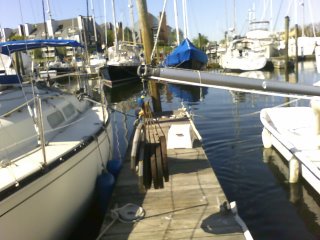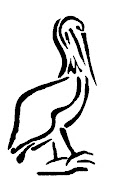 One of the great thing about hanging around marinas and having friends that do things like the Newport to Bermuda race is that you get to see some very cool stuff going on. Often, you get to help, especially if it involves moving a lot of heavy stuff around. How could you not participate in that?
One of the great thing about hanging around marinas and having friends that do things like the Newport to Bermuda race is that you get to see some very cool stuff going on. Often, you get to help, especially if it involves moving a lot of heavy stuff around. How could you not participate in that?We moved Cassiopeia, a Beneteau 42.7 from Norwalk, Connecticut on Saturday - it was just a two hour ride, easy as pie. Since no sails were aboard, no sailing occured, but we still managed to down a box of Triscuits, a pound of Brie cheese, and a hot soprasata. Can't go sailing without food, you know.
Anyway, after arriving at Stanford, Ct. for the summer berth, I took off to my boat, now at the City Island Yacht Club (CIYC from now on). How I got Inertia there is a story of motoring through the rain and fog from Haverstraw the weekend before. That week, it was Triscuits, cheddar cheese, and pepperoni. But that's another story.
I spent the afternoon taking down my small headsail and rehoisting my big genoa. Then I had to go sailing, and because the wind was light, I practiced docking under sail and picking up my mooring under sail. If you own a sailboat, you should do this, too. It's fun and educational. Once again, I digress.

So, after putting the boat away, I had dinner at the club. Let me repeat: I had dinner at the club. I love saying that. My friends will soon get sick of me saying it. I suppose I will, too, when the novelty wears off. But for now, I must reiterate, I had dinner at the club.
Ok, Sunday, (today), we had to go back to Cassiopeia to help the measurer measure her for the Newport - Bermuda race. Laura had two measurements made: ORR and IRC. You can look what they mean somewhere else. But the ORR measurement involves, in addition to some underbody measurements while the boat is out of the water, calculating the righting moment of the boat. For the Newport - Bermuda race, the righting moment must be 115 degrees or better.
 The righting moment is a measurement of the ability of a boat to right itself if knocked down. Clearly, a boat with a low righting moment, like 90 degrees means that if the boat assumes an attitude of mast parallel to the water or lower, it will continue and turn over. That's not good. Boats like Sunfish's and so forth have a low righting moment - very easy to turn over. 115 degrees means that the mast can be up to 115 degrees from verticle and the boat will still right itself.
The righting moment is a measurement of the ability of a boat to right itself if knocked down. Clearly, a boat with a low righting moment, like 90 degrees means that if the boat assumes an attitude of mast parallel to the water or lower, it will continue and turn over. That's not good. Boats like Sunfish's and so forth have a low righting moment - very easy to turn over. 115 degrees means that the mast can be up to 115 degrees from verticle and the boat will still right itself. If you could get a boat to behave like a Weeble (Weebles wobble but they don't fall down), the you could have a really safe boat.
If you could get a boat to behave like a Weeble (Weebles wobble but they don't fall down), the you could have a really safe boat.The way to measure this is to hang long poles out from the boat with lots of weight on them - and then move the weights and measure what happens to the
 boat. Well, it's a little more complex than that, but essentially, you want to tip the boat and see how hard it was to do.
boat. Well, it's a little more complex than that, but essentially, you want to tip the boat and see how hard it was to do.Also, because there are other measurement systems, like IRC, other rules apply; namely, you have to remove everthing from the boat except what it came with. Do you have any idea how much crap an empty boat has in it? Laura emptied hers before winter. This is what's left. Or half of it anyway. It continues along the finger, too.

 Once the deck measuring was done, we sent Laura up the mast for all the measurements for sail hoist, mast height, and headstay length.
Once the deck measuring was done, we sent Laura up the mast for all the measurements for sail hoist, mast height, and headstay length. In case you're wondering what this whole thing costs besides a few hours with all your friends moving all your crap around is about $600. If you're serious about racing, especially offshore, this is what you'll need to do.
On another entirely different note, there is a company in Northport, Long Island that is owned and run by a really cool guy- a boater's engineer. The company is Sailor's Solutions, and I've put the link on the sidebar. If nothing else, call and get a catalog. There's really stuff you need and didn't know you needed it or that it even existed.
Their flagship product used to be their very own designed and manufactured sound proofing for engine rooms called SPM. If your engine is noisy and your sound insulation is falling apart, replace it with this stuff. It's great. I used it and even though I couldn't get to the aft wall of the engine room to remove or replace the old stuff, installing SPM still reduced the engine noise so much that I could actually listen to the radio down below when motoring. Highly recommended. It's strong (not like that mylar/foam stuff), it's solid foam with stiff surface, and it sticks like the dickens.
After I replaced all my interior lights with the LED's I started looking for navigation lights. It turns out Sailor's Solutions has designed and manufactured with the help of NASA some very cool lighting solutions. They were kind enough to send me a SensiBulb (their name) to try out. It has a slew of advantages, including being a yellowish light instead of the blue white, and it has temperature sensing so that it doesn't allow the LEDs to get too hot. Apparently they fail at 140 degrees - I didn't know that.
Soon they'll be carrying the new OPM navigation lighting. I want it. They'll have the best price, too, since I've also asked about that, too.
So more on that later - but really, give them a shout. I got a copy of their catalog and darn it all, there's stuff I want - even a really excellent winch handle holder. You don't know you need it. But you do. Trust me.
Anyway, it's sailing season - so now I really will see you on the water!







